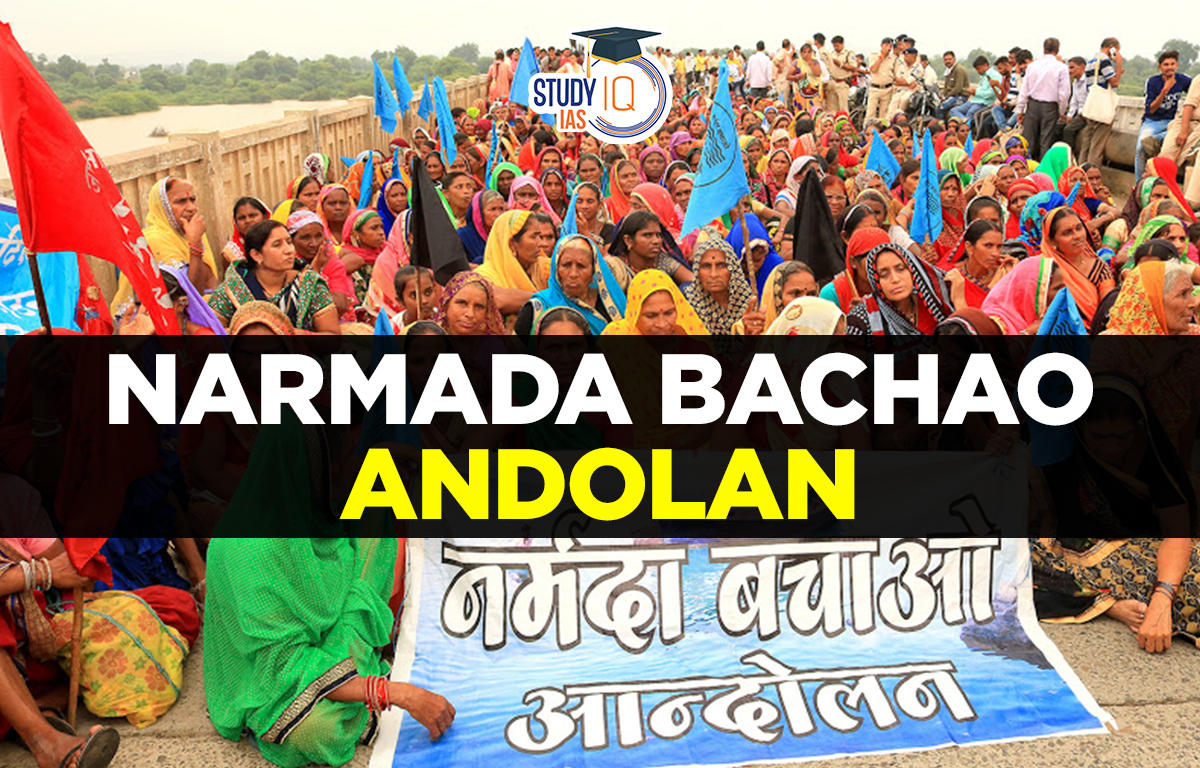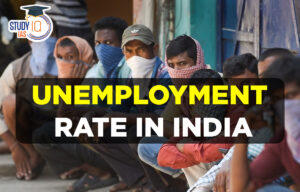Table of Contents
In India, the Narmada Bachao Andolan is a social movement that was started in 1985 by local tribal people, farmers, conservationists, and human rights advocates to protest several major dam construction projects on the Narmada River, which runs through the states of Madhya Pradesh, Maharashtra, and Gujarat. One of the key subjects on the UPSC syllabus, “Narmada Bachao Andolan,” and the Save Narmada Movement of 1985 will be covered in this article.
Narmada Bachao Andolan History
The Narmada River flows through the states of Gujarat, Madhya Pradesh, and Maharashtra. The Narmada Bachao Andolan (NBA) is an Indian social movement opposing a number of large-scale dam proposals across this river. It is led by local tribal people (adivasis), farmers, environmentalists, and human rights activists. One of the largest dams on the river is the Sardar Sarovar Dam in Gujarat, which served as one of the movement’s early focus points.
It is a component of the Narmada Dam Project, whose primary goals are to give the residents of the aforementioned states access to irrigation and electricity. Campaign tactics used by NBA include judicial actions, hunger strikes, rallies, and enlisting the support of well-known figures in the film and art worlds.
Narmada River
- The Narmada River, the longest west-flowing river on the Indian peninsula, passes through the states of Maharashtra, Rajasthan, Gujarat, and Madhya Pradesh.
- The river travels 1312 km along its path, passing through rocky gorges, agricultural areas, hills, and dense forests before emptying into the Arabian Sea.
- The Maikal, Vindhya, and Satpura mountain ranges encircle these tributaries on three sides, while the fourth side empties into the Arabian Sea.
- This river system in India has 41 tributaries.
- Due to the abundance of natural resources along the Narmada River, more than 81% of the surrounding region is made up of villages, tribal populations, including the Baigas, Gonds, and Bhils, and individuals who work primarily in agriculture.
Narmada Bachao Andolan Causes
The land of the people was submerged when the Narmada Dam was built over the Narmada River. 3000 small and large dams were constructed as part of this project. The Sardar Sarovar Dam, one of the main dams, was intended to displace more than 25000 people. Medha Patkar and her associates began the most effective mass movement, the Narmada Bachao Andolan, in 1985 in opposition to the building of massive dams over the river for the rehabilitation or relocation of the affected people after observing the effects.
Also Read: Chipko Movement
Narmada Bachao Andolan Feature
- The Narmada, also known as the Reva, is the fifth-longest river in India.
- The government demanded the development of large, medium, and small dams on the river after independence in order to support regional and governmental growth.
- The building of the Sardar Sarovar and Narmada Sagar dams was suggested. The Narmada Valley Development was authorised by the Narmada Water Disputes Tribunal.
- There were 3000 small dams, 135 medium dams, and 30 large dams in the undertaking.
- It was also proposed that the Sardar Sarovar dam’s height be increased.
- In 1985, after the project’s clearance, Medha Patkar and her coworkers made the decision to go to the location.
- She observed that the project’s work was being reviewed pursuant to directives from the Indian government’s Ministry of Environment and Forests.
- In 1987, work on the Sardar Sarovar Dam started.
- The people who were meant to be impacted by the dam’s construction, however, were not the subject of any research. Maybe they received therapy.
- 2000 individuals organised the Narmada Bachao Andolan in May 1990 after observing the state of the populace.
- The PM’s home in New Delhi was the site of a five-day sit-in.
- This action caused PM to reevaluate the Narmada Valley Development Project.
- Additionally, the Narmada People’s Progress Struggle March was started by 6000 men and women in December 1990.
- Over 100 kilometres were marched during this Yatra.
- Baba Amte and his seven-person crew began a 22-day hunger strike in January 1991.
- The Sardar Sarovar Dam’s work finally resumed in 1999.
- It was dedicated in 2017, and construction on it lasted until 2006.
- The project’s height was raised to 163m.
Narmada Bachao Andolan Leaders
Narmada bachao andolan was led by Medha Patkar and Baba Amte, who was given the Right Livelihood Award in 1991, were the main Narmada Bachao Andolan spokespersons.
Narmada Bachao Andolan Protest Activities
- The opposition to the construction of the Sardar Sarovar Dam on the Narmada River in Gujarat, India’s most western state rapidly developed into a Nongovernmental Organization (NGO) that united farmers, tribal members, environmentalists, and human rights, advocates.
- Along with peaceful protests, protesters have run elaborate media campaigns.
- Examples of such tactics include hunger strikes, famous endorsements in the art and film industries, and others.
- The dam first came under judicial scrutiny in 1985 when Medha Patkar, who was 35 at the time, petitioned the Supreme Court to have it struck down due to poor R&R.
- In May 1990, the Narmada Bachao Andolan organised a 2,000-person, five-day sit-in at Prime Minister V. P. Singh’s home in New Delhi, which persuaded him to reevaluate the project.
- The Narmada Jan Vikas Sangharsh Yatra (Narmada People’s Progress Struggle March), which covered more than 100 kilometers, was started in December 1990 by about 6000 men and women.
- In January 1991, Baba Amte and the seven-person team started a sit-until-you-die hunger strike that endured 22 days.
- Finally, in 2017, the Supreme Court mandated that each family impacted by the Sardar Sarovar project on the Narmada River receive final recompense in the amount of Rs. 60 lacks.
Narmada Bachao Andolan Challenges
The conflict over the allocation of Narmada water between the three states of Gujarat, Maharashtra, and Madhya Pradesh presented another difficulty for the project. A Narmada Water Dispute Tribunal (NWDT) was established in 1969 to address this problem. The NWDT issued its conclusion in 1979 after reviewing the different reports.
The court’s decision states that the dam would release the 35 billion cubic metres of water for human usage. Madhya Pradesh would receive 65% of it out of the three states, Gujarat would receive 32%, and Rajasthan and Maharashtra would be qualified for the final 3%.
Role of World Bank
- One of India’s most important multipurpose river valley projects is the Narmada Project.
- The government needs money in order to build the dams.
- The World Bank was thus given permission to start the Narmada Project’s building by the Narmada Water Disputes Tribunal.
- As a consequence, in 1985, the World Bank decided to finance the project.
- It gave $450 million towards building the Sardar Sarovar Dam.
- The World Bank came under more pressure to abandon the initiative as a result of the protest that Medha Patkar organised in Washington, D.C.
- Later, the World Bank declared that it would conduct a project evaluation on its own.
- In 1991, it led to the creation of the Morse Commission for Human Displacement, Environmental Cost, and Dam Construction.
- The World Bank’s involvement was discontinued in 1993.
- The leading Narmada Bachao Movement spokesperson Baba Amte and Medha Patkar both won the Right Livelihood Award in 1991.
- This movement has the backing of well-known figures in film and the arts, as well as rallies, hunger strikes, and legal actions.
- Numerous NGOs, activists, and locals all joined the effort.
- The Narmada Dharangrastha Samiti, based in Maharashtra, was the main backing group.
- Narmada Ghati Nav Nirman Samiti is located in Madhya Pradesh.
- Narmada Asargrastha Samiti, located in Gujarat.
Narmada Bachao Andolan Importance
The movement’s primary objective was to stop dam construction while displaced people were being fully rehabilitated and relocated. In India’s political history, it was one of the most important mass campaigns against the government to advocate for environmental protection. To prevent their homes and territory from being submerged, the movement brought together different castes.
The campaign was led by indigenous tribal members, farmers, environmentalists, and human rights advocates. International environmental groups supported it. Additionally, the movement supported people in their struggle for their rights and acted as a check on government oppression.
Narmada Bachao Andolan Success
By increasing public knowledge of the environmental, rehabilitation, and relief aspects of Sardar Sarovar and other Narmada projects, the Narmada Bachao Andolan (NBA) has done a great service to the nation. The following are the main achievements of the Narmada Bachao Andolan: The World Bank was kicked out of the Sardar Sarovar project in 1993, and work was stopped between 1994 and 1999. 1999–2001 – The Maheshwar project was abandoned by foreign investors.
Narmada Bachao Andolan UPSC
Narmada Bachao Andolan is an Indian social movement spearheaded by native tribals, farmers, environmentalists and human rights activists against a number of large dam projects across the Narmada River, which flows through the states of Gujarat, Madhya Pradesh and Maharashtra. Students can read all the details related to UPSC by visiting the official website of StudyIQ UPSC online Coaching.


 Wholesale Price Index (WPI) Latest Data ...
Wholesale Price Index (WPI) Latest Data ...
 Unemployment Rate in India, Current Rate...
Unemployment Rate in India, Current Rate...
 Central Board of Direct Taxes (CBDT), Fu...
Central Board of Direct Taxes (CBDT), Fu...

















